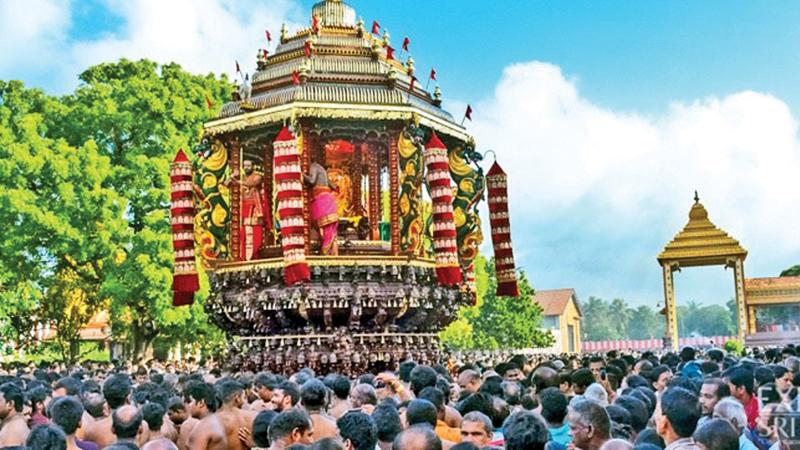
In Hinduism, the Hindu temple chariot and chariot festival have a special meaning. Hindu chariot procession is a common scene all over the world, but most of the general public and Hindu devotees do not know the philosophical meaning of the Hindu chariot.
 Generally the Hindu chariot is often called Ther or Ratham by Hindu people. Hindu chariots are divided into two different varieties. One is Chithra Ther and the other is Kattu Ther. Chithra Ther means permanently made structure out of high quality wood, with excellent crafted sculpture. For this chariot golden and silver metals further adorn the Chithra Ther or Chithra chariot. Kattu Ther or Kattu chariot means temporarily made chariot, covered with colourful cloths.
Generally the Hindu chariot is often called Ther or Ratham by Hindu people. Hindu chariots are divided into two different varieties. One is Chithra Ther and the other is Kattu Ther. Chithra Ther means permanently made structure out of high quality wood, with excellent crafted sculpture. For this chariot golden and silver metals further adorn the Chithra Ther or Chithra chariot. Kattu Ther or Kattu chariot means temporarily made chariot, covered with colourful cloths.
The Hindu chariot is often compared with the human heart and the holy deities are kept in the middle of the chariot on a well-designed platform. It resembles the soul. Often a question arises as to why the Hindu Chariot procession takes place on roads as well as outdoor corridors of the temple with pomp and pageant. It is stated that throughout the year devotees visit the temples to seek the blessings of God, but during the annual chariot festival the Lord visits their doorsteps to pour blessings on them.
In front of the chariot, traditional temple musicians, Natheswaram and Thavil players provide excellent melodious devotional musical contributions to the procession. Behind the chariot the devotees sing devotional Bajans. In front of the chariot a variety of Kaavadies take place. Such a divine atmosphere melts the hearts of the onlookers.
During the road procession of the Hindu chariots devotees, residents and business people stand on both sides of the road and make their offerings. To welcome the Hindu chariots, according to Hindu tradition, people keep the Mandapapadi, Purnakumpam and Banana trees with ripe yellow banana bunches.
Generally, the chariots are always decorated with yellow bulbs, fresh flower garlands, palm leaf, yallies (a particular variety of species looks like seahorse), and thoranam decorations.
Many devotees fulfil their vows by taking Panneer Kaavadi, Pushpa Kavati, Paravai Kaavadi and Anna Kaavadi in front of the holy chariot. Yet a considerable number of devotees break hundreds of coconuts in front of the chariots to fulfil their vows. Some of the devotees carry burning camphor pots on their heads in front of the temple. Some of the male devotees roll themselves (Angapirathaeshtai) on the ground behind the chariot to fulfil their vows. Meanwhile female devotees also get themselves involved in a different way of expressing their devotion by worshipping the routes of the chariot.
Philosophy
 According to Hindu philosophy a beautiful explanation has been given in the Upanishads about the purpose and metaphor of a chariot. The Upanishads explains that in the chariot there are two important people, one is the driver of the chariot and the other is the passenger.
According to Hindu philosophy a beautiful explanation has been given in the Upanishads about the purpose and metaphor of a chariot. The Upanishads explains that in the chariot there are two important people, one is the driver of the chariot and the other is the passenger.
The passenger has no control over the journey. At the hands of the driver the reins are attached to control the bridles of several horses of the chariot. The chariot continuously moves on its path.
The chariot is considered a metaphor for the body. The Soul is considered as the passenger who has no control over its travel. The driver of the chariot is considered the intellect. The reins and bridles in the hands of the driver are considered as the mind.
The horses of the chariot are considered as the senses which constantly gather impressions from the world. The travel route of the path represents human life. The senses are in touch with the external world. They transfer the senses to the mind.
Again the mind transfers them to the intellect for analysis. The decision making involves the process of determination of right and wrong, and good and bad. The driver controls the chariot by using the reins.
According to Siva Puranam, the Chariot is driven by Lord Siva. The two main wheels of the Chariot are considered as the Sun and the Moon. In Hinduism there are four Vedas that include Rig, Yajur, Sama, and Atharva.
They are considered as the four horses. Eight Nagas (cobras) portray the leashes. Sixteen Kalais are designed as planetary movement of Amavasai (Dark full Moon) to Puranai (Full Moon day). The 16 Kalais are considered as 16 pillars of the chariots. The sky is considered as the roof of the Ratham. Vayu Deva is considered as the flag of Ratham.
The Hindu temple chariot festival occupies a special place in the hearts of Hindu devotees all over the world.
